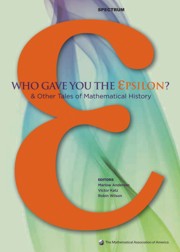Book contents
- Frontmatter
- Introduction
- Contents
- Analysis
- Geometry, Topology and Foundations
- Algebra and Number Theory
- Foreword
- Hamilton's Discovery of Quaternions
- Hamilton, Rodrigues, and the Quaternion Scandal
- Building an International Reputation: The Case of J. J. Sylvester (1814–1897)
- The Foundation Period in the History of Group Theory
- The Evolution of Group Theory: A Brief Survey
- The Search for Finite Simple Groups
- Genius and Biographers: The Fictionalization of Evariste Galois
- Hermann Grassmann and the Creation of Linear Algebra
- The Roots of Commutative Algebra in Algebraic Number Theory
- Eisenstein's Misunderstood Geometric Proof of the Quadratic Reciprocity Theorem
- Waring's Problem
- A History of the Prime Number Theorem
- A Hundred Years of Prime Numbers
- The Indian Mathematician Ramanujan
- Emmy Noether
- “ Marvelous Proof,”
- Afterword
- Surveys
- Index
- About the Editors
Waring's Problem
from Algebra and Number Theory
- Frontmatter
- Introduction
- Contents
- Analysis
- Geometry, Topology and Foundations
- Algebra and Number Theory
- Foreword
- Hamilton's Discovery of Quaternions
- Hamilton, Rodrigues, and the Quaternion Scandal
- Building an International Reputation: The Case of J. J. Sylvester (1814–1897)
- The Foundation Period in the History of Group Theory
- The Evolution of Group Theory: A Brief Survey
- The Search for Finite Simple Groups
- Genius and Biographers: The Fictionalization of Evariste Galois
- Hermann Grassmann and the Creation of Linear Algebra
- The Roots of Commutative Algebra in Algebraic Number Theory
- Eisenstein's Misunderstood Geometric Proof of the Quadratic Reciprocity Theorem
- Waring's Problem
- A History of the Prime Number Theorem
- A Hundred Years of Prime Numbers
- The Indian Mathematician Ramanujan
- Emmy Noether
- “ Marvelous Proof,”
- Afterword
- Surveys
- Index
- About the Editors
Summary
What follows is a non-scholarly survey of the history of Waring's problem. Although a few easy things are proved along the way, the paper is mostly concerned with telling stories—in other words, quoting many beautiful theorems without proof. The proofs, for the most part, involve hard-core analysis, and are difficult. Anyone wishing to pursue the subject should examine chapters 20 and 21 of Hardy and Wright [4] and then [1] and [2]. Ellison's paper [2] provides a much more scholarly and detailed version of the story, with many proofs and an extensive bibliography; the present informal version should serve a useful role as an introduction to [1] and[2].
Waring's problem began with EdwardWaring, who published a book entitled Meditationes Algebraicae in 1770, in which, among other things, the following remarkable assertion occurs:
Every number is the sum of 4 squares; every number is the sum of 9 cubes; every number is
the sum of 19 biquadrates (4th powers); and so on.
(Here, and throughout, number means natural number, possibly 0.)
The assertion for squares is much older: it is hinted at in Diophantus (roughly third century AD) and stated explicitly by Bachet in 1621. Fermat claimed to have a proof in 1641, but in 1770 when Waring's book appeared, the 4-squares theorem was a wellknown “fact” for which no proof was known. It was proved later in the same year by Lagrange, to the chagrin of Euler, who had tried unsuccessfully to find a proof.
- Type
- Chapter
- Information
- Who Gave You the Epsilon?And Other Tales of Mathematical History, pp. 313 - 317Publisher: Mathematical Association of AmericaPrint publication year: 2009



